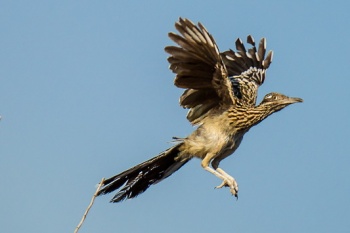- Geococcyx californianus
Identification
L. 51-61 cm (20-24 in.)
Ws. 81 cm (32 in.)
Usually seen walking or running along desert terrain, weaving skillfully through openings in fences or underbrush.
- Upper parts, chin, and chest are heavily streaked brown and white;
- Buff belly
- Shaggy crest on head, not always erect
- Bill long and stout with hooked tip.
- Long pale blue legs and feet
- Sometimes has a patch of bare skin behind the eyes with colors of blue, red and orange.
- Males and females similar, but males with orange facial skin.
- Immatures similar to adult female but have less bronze gloss on their tertials.
Distribution
Mexico, southwest and southern midwest states of USA, in suitable terrain.
Taxonomy
Most authorities now classify this as a monotypic species[1]. In the past up to four poorly differentiated subspecies were recognized: californianus, kongligi, conklingi, and dromicus[2].
Habitat
Dry, hot country. Scrub, chapparal, agricultural areas, urban fringes.
Behaviour
Spends most of its time on the ground, often solitary. Flies with reluctance, especially if threatened, when it will fly into brush cover to hide. Flying is more of an open, extended-wing gliding, from the nest or other high perch.
Can be quite tame where not persecuted. This fairly common member of the cuckoo family (Cuculidae) was called the Ground Cuckoo in centuries past, because it was often seen running along in front of carriages. They can still be commonly seen darting across or along roads, although at a peak speed of 15mph, they can no longer keep up with traffic.
Diet
Runs to catch snakes, lizards, small birds and rodents. One of the only animals known to attack rattlesnakes.
Breeding
A monogamous breeder.
Vocalisations
Mournful dove-like “coo” notes, slow and descending in pitch; also a bill-rattle.
Movements
Resident. Pair remains on territory all year and in successive years.
References
- Clements, J. F., T. S. Schulenberg, M. J. Iliff, S. M. Billerman, T. A. Fredericks, B. L. Sullivan, and C. L. Wood. 2019. The eBird/Clements Checklist of Birds of the World: v2019. Downloaded from http://www.birds.cornell.edu/clementschecklist/download/
- https://avibase.ca/DB5DABCF
- Hughes, J. M. (2011). Greater Roadrunner (Geococcyx californianus), version 2.0. In The Birds of North America (A. F. Poole, Editor). Cornell Lab of Ornithology, Ithaca, NY, USA. https://doi.org/10.2173/bna.244
- Hughes, J. M. (2020). Greater Roadrunner (Geococcyx californianus), version 1.0. In Birds of the World (A. F. Poole, Editor). Cornell Lab of Ornithology, Ithaca, NY, USA. https://doi.org/10.2173/bow.greroa.01
Recommended Citation
- BirdForum Opus contributors. (2025) Greater Roadrunner. In: BirdForum, the forum for wild birds and birding. Retrieved 3 May 2025 from https://www.birdforum.net/opus/Greater_Roadrunner
External Links:
GSearch checked for 2020 platform.1








